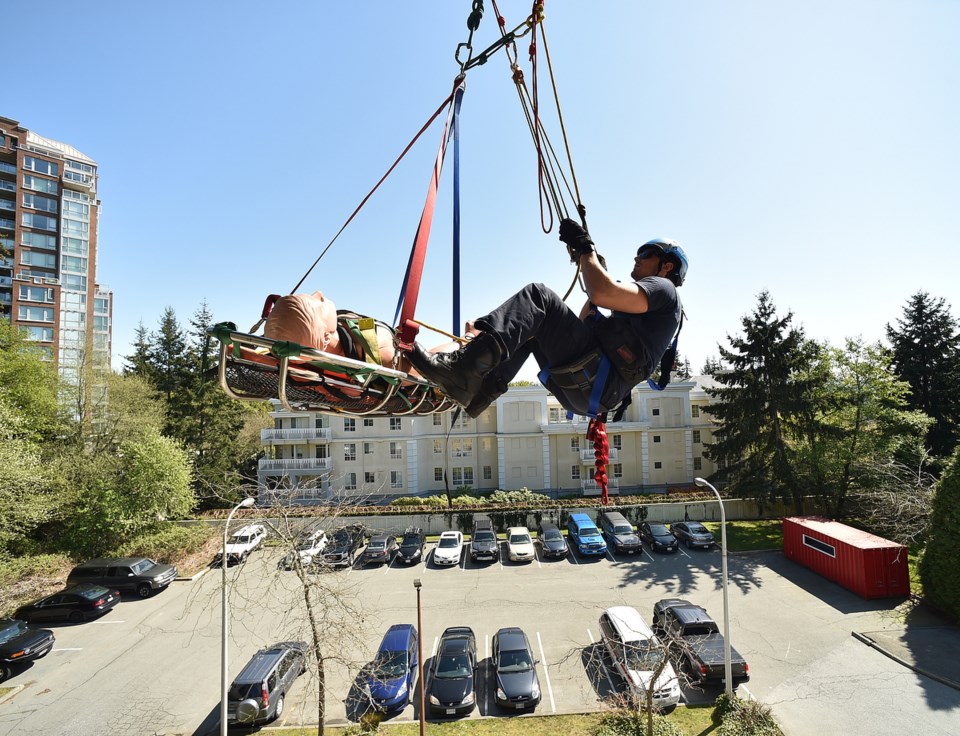When emergencies happen high above the city’s streets, it’s often Vancouver’s Special Operations Team that comes to the rescue.
The team of firefighters trains for emergency situations involving things such as tower cranes, high-rise buildings and bridges, using high-angle rope rescue techniques.
“Anywhere where someone perhaps could be trapped and/or find themselves in medical distress,” said A/Lt. Christopher Won, who has been with the team since 2007.
The team uses a system of ropes, harnesses and pulleys to access and extract people from precarious situations, often dealing with a medical emergency at the same time, and bring them back down to earth.
The dedicated team was first established in the early 1990s. At that time, it exclusively trained in high-angle rope rescue techniques. Since then, they have added other rescue disciplines and now oversee confined space rescues, trench rescues and water rescues in the city.
“We also oversee the structural collapse and earthquake or disaster management aspect of rescue within the city,” Won said.
But high-angle rescue was the “bread and butter” of the program when it began, and while the team might not get calls daily, weekly, or even monthly — the team was called out just eight times last year —they have to be ready to respond at any time.
Training, training, training
“One of the paradoxes of the technical rescue world is because the frequency of rescues is not very high, we have to make up for that experience through a lot of training,” Won said, adding that, for example, the team doesn’t do as much first aid training because, as firefighters, they use those skills daily.
“The reverse goes for the technical rescue — we’re not getting a technical rescue call every day, so we do spent a lot of time training especially because we have the four disciplines that we have to maintain our skills for.”
He said the team has four to six full training days every six weeks or so.
The department has its dedicated training facility near Strathcona Park, which includes a four-storey burn tower, but the team takes training sessions out into the real world as much as possible.
“We have a really good relationship with the port right now so we’ve done training off some of their gantry cranes and things like that that load the shipping containers on and off the ships,” he said.
“We also have a really good relationship with some of the real estate development companies in town that build the high rises so we try to use them when the weather’s good, get up on the tower cranes… you look around the city and there’s no shortage of tower cranes.”
Incidents involving tower cranes, often rescuing a crane operator who is in medical distress and unable to climb down, are usually some of the team’s higher profile rescues. But as Won reflects on his more than 10 years with the team, it’s other kinds of calls that have stuck with him.
“The ones that stand out are sometimes people who have chosen to go out into the high-angle environment and then realized halfway through that it wasn’t such a great idea,” he said. “So whether they were trying to get that perfect Instagram photo or they went hiking and they realized they were up on the side of a bluff and they got themselves into trouble… there’s always this element of embarrassment, there’s some lengthy explanation as to why they did what they did and you’ve got to navigate your way through this conversation while trying to rescue them from the position they’re in.”
Won said the explanations he’s heard over the years usually tend to be “fairly convoluted.”
“One was out at UBC above Wreck Beach where there’s very steep slopes… [Someone decided to] climb naked from the beach trying to find a shortcut back to where they hid their alcohol or something and it just… The nakedness and the alcohol and the climbing up the bluff, it doesn’t line up to me to a good decision, but [they] decided it was a good idea.”
Higher ground
The ever-increasing height of buildings in the city has meant new challenges for the team.
When the Shangri-La, currently the tallest high-rise in the city at 659 feet (201 metres), was completed in 2008, the department had to not only purchase longer ropes, but also had to get permission to use them. Won said WorkSafeBC and industry safety standards allow for a maximum 300-foot-long ropes for high-angle rescue.
“Because of [the height of] the Shangri-La we’ve had to order and maintain 600-foot ropes,” he said. “So we had to get a variance to clear that with WorkSafe that we could use these extra-long ropes simply because the length of the [standard] rope wouldn’t reach the ground if it was only 300 feet.”
Higher buildings and longer ropes raise new questions.
“So as we get higher and higher, we’re going to have to deal with what is the safety factor in a rope of 600 feet or 700 or 800? As we go higher and higher, is it realistic to continually use a single rope? Maybe we’ll come up with techniques to relay that person from one 600 length to the next 600 length,” Won said, adding that discussions around emergency response for the Shangri-La started during the construction phase, something that will continue if, and when, the next tallest building in the city is approved.
“At the end of the day, once a building gets permitted to go up a certain number of floors, we look at well, do we have the capability? And if we don’t, how do we perform these rescues?”
@JessicaEKerr
Read more �鶹��ýӳ��from Above stories



